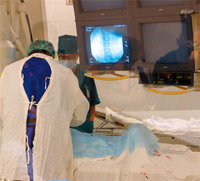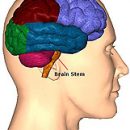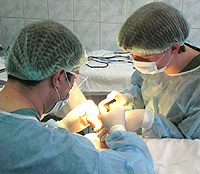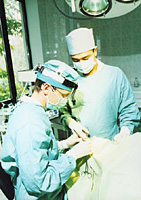Very often anesthesia scares people even more than the operation itself. Unknowns are scared, possible unpleasant feeling when falling asleep and awakening, and numerous talk about harmful to health consequences of anesthesia. What is modern anesthesia? And as far as it is safe for the children's body?
Content
In most cases, we only know about anesthesia that the operation under its impact passes painlessly. But in life it can happen that these knowledge will be not enough, for example, if the issue of the operation for your child is resolved.
What you need to know about anesthesia?
Anesthesia, or general anesthesia, is a time-limited drug impact on the body, in which the patient is unconscious when painkillers are introduced, with the subsequent restoration of consciousness, without pain in the operation of the operation.
Anesthesia may include a patient with artificial respiration, ensuring the relaxation of muscles, laying droppers in order to maintain the constancy of the inner environment of the body using infusion solutions, control and reimbursement of blood loss, antibiotic porphylaxis, prevention of postoperative nausea and vomiting and so on. All actions are aimed at the fact that the patient suffered operational intervention and «woke up» After the operation, without experiencing discomfort.
Types of anesthesia
 Depending on the method of conducting anesthesia, there is an inhalation, intravenous and intramuscular. The choice of a method of anesthesia lies on a anesthesiologist and depends on the state of the patient, on the type of surgical intervention, on the qualifications of the anesthesiologist and surgeon and T.NS., After all, for the same operation can be appointed different general anesthesia. Anesthesiologist can mix different types of anesthesia, achieving an ideal combination for a given patient.
Depending on the method of conducting anesthesia, there is an inhalation, intravenous and intramuscular. The choice of a method of anesthesia lies on a anesthesiologist and depends on the state of the patient, on the type of surgical intervention, on the qualifications of the anesthesiologist and surgeon and T.NS., After all, for the same operation can be appointed different general anesthesia. Anesthesiologist can mix different types of anesthesia, achieving an ideal combination for a given patient.
Narcosis is conditionally divided into «small» and «large», It all depends on the number and combination of drugs of various groups.
TO «Little» Drugs can be attributed to inhalation (hardware-mask) anesthesia and intramuscular anesthesia. In the hardware and mask anesthesia, the child gets an anesthetic drug in the form of an inhalation mixture during self-breathing.
Package drugs introduced into the organism in the form of inhalation are called inhalation anesthetics (fluorotan, isofluone, sevofluone). This type of general anesthesia is used in small-acting, short operations and manipulations, as well as various types of research, when a short-term shutdown of child's consciousness is required. Currently, inhalation anesthesia is most often combined with local (regional) anesthesia, since in the form of mononarchosis is not effective enough.
Intramuscular anesthesia is now practically not used and goes into the past, since the anesthesiologist can absolutely cannot manage the action on the patient's body of this type of anesthesia. In addition, the drug, which is mainly used for an intramuscular type of anesthesia - ketamine, - according to the latest data is not so harmless to the patient: it turns off for a long time (almost six months) long-term memory, preventing the full development of the child.
«Large» Anesthesia is a multicomponent pharmacological impact on the body. Includes the use of such medicines as narcotic analgesics (do not be confused with drugs), muscle relaxants (preparations, temporarily relaxing skeletal muscles), sleeping pills, local anesthetics, a complex of infusion solutions and, by the need for blood. Drugs are introduced both intravenously and inhaled through the lungs. Patient during the operation is carried out artificial ventilation of the lungs (IVL).
Are there any contraindications?
There are no contraindications to anesthesia, except for the failure of a patient or his relatives from anesthesia. At the same time, many operational interventions can be carried out without anesthesia, under local anesthesia (anesthesia). But when we are talking about the comfortable condition of the patient during the operation, when it is important to avoid psycho-emotional and physical stress, it is necessary to anesthesia, that is, the knowledge and ability of a anesthesiologist's doctor need. And not necessarily anesthesia in children is used only during operations.
 Anesthesia may be required with a multitude of diagnostic and medical events, where it is necessary to remove anxiety, turn off the consciousness, to give the opportunity to the child do not remember the unpleasant sensations, about the absence of parents, about a long forced position, about a dentist with brilliant tools and bormer. Wherever the calm of the child needs, you need a anesthesiologist - a doctor whose task is to protect the patient from operational stress.
Anesthesia may be required with a multitude of diagnostic and medical events, where it is necessary to remove anxiety, turn off the consciousness, to give the opportunity to the child do not remember the unpleasant sensations, about the absence of parents, about a long forced position, about a dentist with brilliant tools and bormer. Wherever the calm of the child needs, you need a anesthesiologist - a doctor whose task is to protect the patient from operational stress.
The planned operation is important to consider such a moment: if the child has concomitant pathology, it is desirable that the disease be out of exacerbation. If the child got a sharp respiratory viral infection (ORVI), then the period of recovery is at least two weeks, and it is desirable to not hold planned operations during this period of time, since the risk of postoperative complications is significantly increased and breathing problems may occur, because respiratory infection First of all amazes the respiratory tract.
Before the operation, an anestziologist will definitely talk to the abstract topics: where the child was born, how born whether vaccinations were made and when they were growing, as they had developed, whether there was an allergy, he examines the child, get acquainted with the history of the disease, scrupulously examine everything Analyzes. He will tell that it will happen to your child before surgery, during the operation and in the nearest postoperative period.









